Since making his first steps into first-team football at Lille back in 2016, aged just 19 years old, Martin Terrier’s career has seen plenty of ups and downs, along with plenty of instability. At just 24, Terrier (184cm/6’0, 73kg/160lbs) has already played for four different clubs in Ligue 1 — Lille, Strasbourg, Lyon, and Rennes.
The “versatile” attacker, who’s comfortable playing at centre-forward, as a second-striker, as an attacking midfielder, or on either wing — especially the left-wing — seems to have found a suitable home for himself at Roazhon Park, however. Last season was Terrier’s most prolific in France’s top-flight, in terms of goal contributions. The 24-year-old ended the 2020/21 league campaign with nine goals and seven assists to his name. Terrier has had similarly impressive seasons to this in the past, notably scoring nine league goals for Lyon in 2018/19, but the difference at Rennes may be that he’s following his impressive season up with yet another high-scoring campaign. Terrier currently has five goals and one assist to his name in Ligue 1 this term, while he’s generated an impressive 4.62 xG and 2.1 xA — highlighting his threat in front of goal both as a scorer and creator.
Terrier is more than just direct goal contributions, his value to Rennes is evident every time he’s involved in an attacking passage of play. Per Understat, the former France U21 international has got the highest xGChain (total xG of every possession the player is involved in) of any Rennes player this season, 9.88xGC. This leaves him with an impressive 0.93 xGC per 90 for the 2021/22 campaign. As explained by Statsbomb, this is a statistic that credits players for attacking contributions other than shots and assists, and can provide a more comprehensive look at attacking contribution, in some ways, to get a more complete idea of a player’s value to the attack. As we can see, Terrier is very valuable to Rennes.
Additionally, the Rennes attacker isn’t just an asset during possession phases, but also in out-of-possession phases. As we’ll go on to discuss, Terrier’s defensive contribution is undoubtedly one of the strongest elements of his game. This, in turn, becomes another offensive tool for Terrier and Rennes, as he’s good at forcing high turnovers in dangerous areas of the pitch from where he and his side can counter to hurt the opposition, while he’s a great counter-attacking threat from situations when Rennes have won the ball in deeper areas too, thanks to his movement and pace.
This tactical analysis and scout report aims to highlight three of the biggest strengths to Terrier’s game that have made him Les Rouge et Noir’s key cog since the arrival of Bruno Génésio at Roazhon Park, back in March. I hope to give readers some greater insight into Terrier’s game and highlight a budding star who’s got the potential to end this season with much higher stock than he’s had before.
The 24-year-old has likely still not entered his prime years but is performing very well for a Rennes side currently sitting third in France’s top-flight. He’s currently valued at €13m, per Transfermarkt, with a contract that runs until the summer of 2025, while he moved to Rennes from Lyon for €12m just over a year ago. For me, this is excellent value considering the attacker’s versatile skill-set and the all-around package he offers on the pitch. Stylistically, Terrier is in the mould of Antoine Griezmann, currently on loan at Atlético Madrid from their La Liga rivals Barcelona, as I think he’s shown great ability to perform a similar role within his team’s strategy and tactics to a high level in one of Europe’s strongest leagues, which I hope to convey via this tactical analysis.
Defensive contribution
Terrier performs very well in terms of defensive statistics when compared to other strikers, wingers and attacking midfielders from Ligue 1, as well as from the other four leagues that make up Europe’s top-five. The Rennes man has completed 5.43 successful defensive actions per 90 this term, which is a relatively high number. He also has a very good defensive duel success rate (58.49%) for an attacker, highlighting his efficiency with winning the ball back when he does commit to challenging for it.
Les Rouge et Noir have been one of France’s most aggressive sides without the ball this season, as highlighted by their relatively low PPDA of 9.86, which ranks fourth-lowest in Ligue 1 — essentially indicating that Rennes have deployed the fourth-most aggressive press in their league this season. Terrier plays a big part in his side’s pressing success. His 89 pressures in the attacking third rank him behind just four other Ligue 1 players for pressures in the attacking third this season, while he’s also managed to make 57 successful pressures in total this term, which also ranks pretty highly among Ligue 1 players (of any position).
When compared to other forwards (with Terrier mainly playing as a forward, as opposed to a winger/attacking midfielder, in this time) from Europe’s top-five leagues in the last calendar year, Terrier ranks in the 89th percentile for tackles, 90th percentile for tackles won, 99th percentile for tackles in the attacking third, and 89th percentile for successful pressures, highlighting the fact that the 24-year-old is an excellent asset for his side in defensive phases who offers far more than the vast majority of forwards. With defensive work rate, contribution, and skill becoming increasingly spotlighted as an area of importance in football today, even for forwards, this immediately makes Terrier a standout.
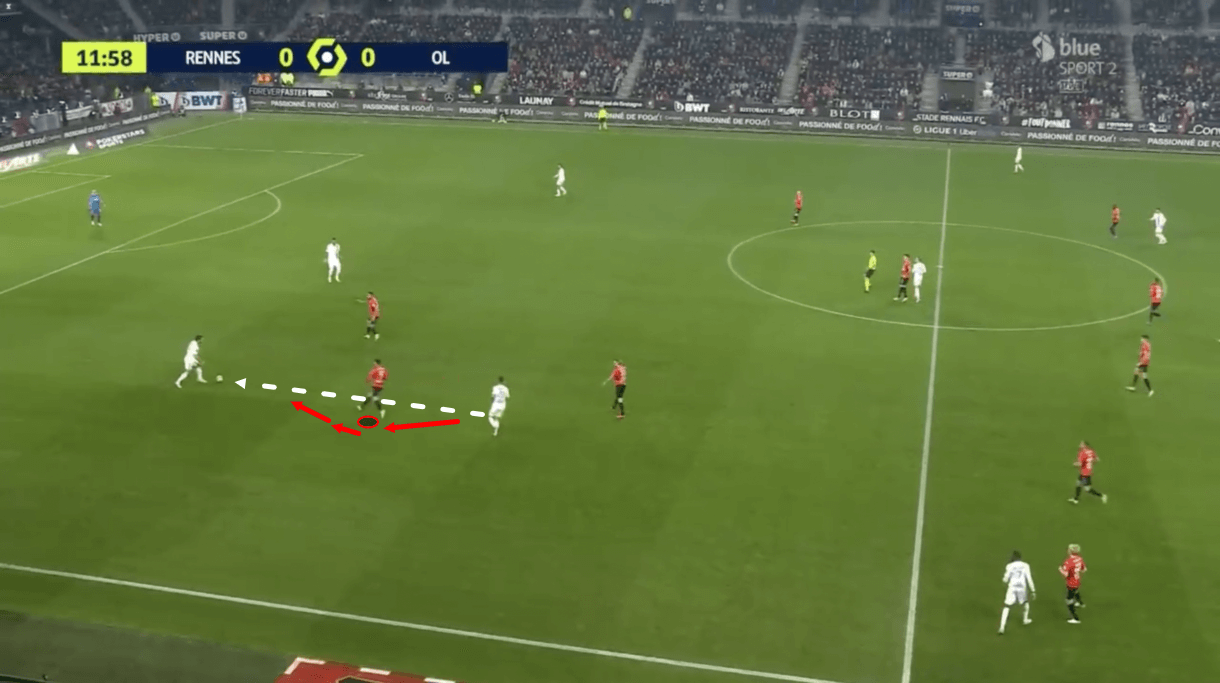
Figures 1 and 2 highlight an example of the Rennes attacker pressing the opposition high. This passage of play emphasizes the 24-year-old’s ability to press intelligently and with technical proficiency versus high-level opposition, in his former side, Lyon. Just before figure 1, the opposition midfielder now just behind Terrier passed the ball back to the teammate occupying a right centre-back position in the backline at this moment. This backpass acted as a trigger for Terrier to spring into action and start closing down the receiver, as we see in figure 1.
Terrier doesn’t just run quickly and in any direction, however; he presses with intelligence. Note how the Frenchman keeps the closest midfielder in his cover shadow while pressing the right centre-back. Terrier also bends his run here, angling himself to approach the ball-carrier from out-to-in to force play inside, where Rennes have got a very strong defensive structure set up at this moment.
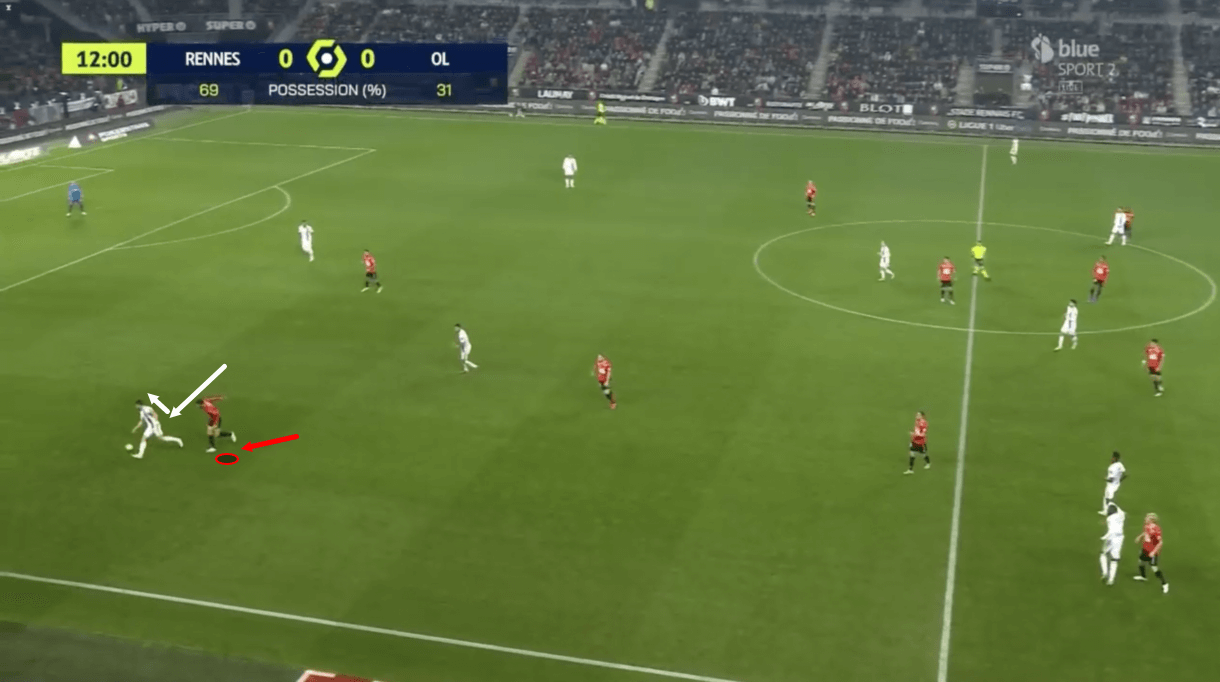
The opposition player tried to go on the outside despite Terrier’s pressing angle, as a result of the passing options on the inside being so unappealing due to Rennes’ superiority in this area. However, as figure 2 shows us, the ball-carrier was unable to beat Terrier and was ultimately forced to go backwards. This highlights both the effectiveness of Rennes’ overall defensive structure and Terrier’s effectiveness as a pressing forward. The 24-year-old is very good at jockeying opposition players as we saw here, preventing them from getting past him while keeping viable forward passing options in his cover shadow.
Terrier generally presents a constant threat to the ball in situations like this, while jockeying, he acts aggressively with his feet and does try to nip in and take the ball away from the ball carrier’s control if a window of opportunity opens, even for a split second. However, a great ability of his is that he very rarely overcommits to challenges, leaving himself open to being beaten too easily. Terrier is great at sticking a foot in while jockeying at pace and maintaining his balance. This helps him to challenge for the ball while still maintaining a good defensive body position and retaining an advantage over the attacker. This was successful in figure 2, with the ball-carrier being forced to go backwards. This allowed Terrier and his teammates to push up even more, further compressing the area of pitch in which the opposition can play and making it more difficult for them to play out from the back successfully.
Furthermore, Terrier is a very quick player with fast acceleration. This helps him to close opponents down quickly, reducing their decision-making time and, when combined with his intelligent pressing and technical defending ability, helps to increase his chances of regaining possession for his side.
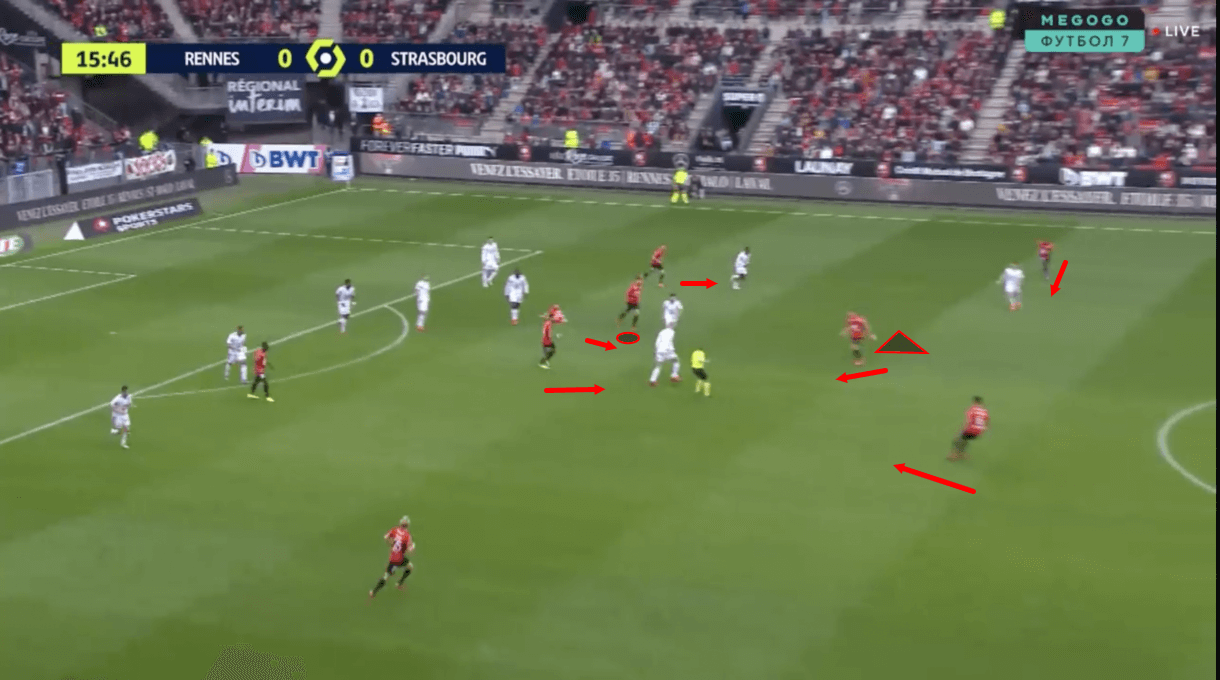
Terrier is also a great asset for his team in counter-pressing situations, which figures 3 and 4 highlight. Génésio’s side love to counter-press, so this is a skill that the attacker showcases fairly frequently and one that’s important within his side’s strategy and tactics. Starting with figure 3, this image shows an example of a typical counter-pressing situation for Rennes. The opposition have just won the ball deep and played a pass into the midfielder we see in possession here, nearest to the referee.
At this moment, Rennes’ shape is very important, with Les Rouge et Noir’s players covering the ball carrier’s passing options and potential dribbling pathways through their positioning and pressure, as illustrated in the image above. Positioning is key following a turnover of possession high up the pitch. Deeper, more conservatively positioned players must be alert to the opposition’s biggest threats on the counter and position themselves to control those options while reacting to the opposition’s progression upfield. In this example, the ball-carrier and the three most advanced players in white shirts to his left are the major counter-attacking threats for Rennes but Les Rouge et Noir are deploying a good defensive shape that restricts the opposition’s field of play, caging them in to an extent and compressing their space to make it more difficult for them to counter-attack.
In this example, we see Terrier positioned quite centrally, applying backwards pressure to the ball carrier’s nearest passing option.
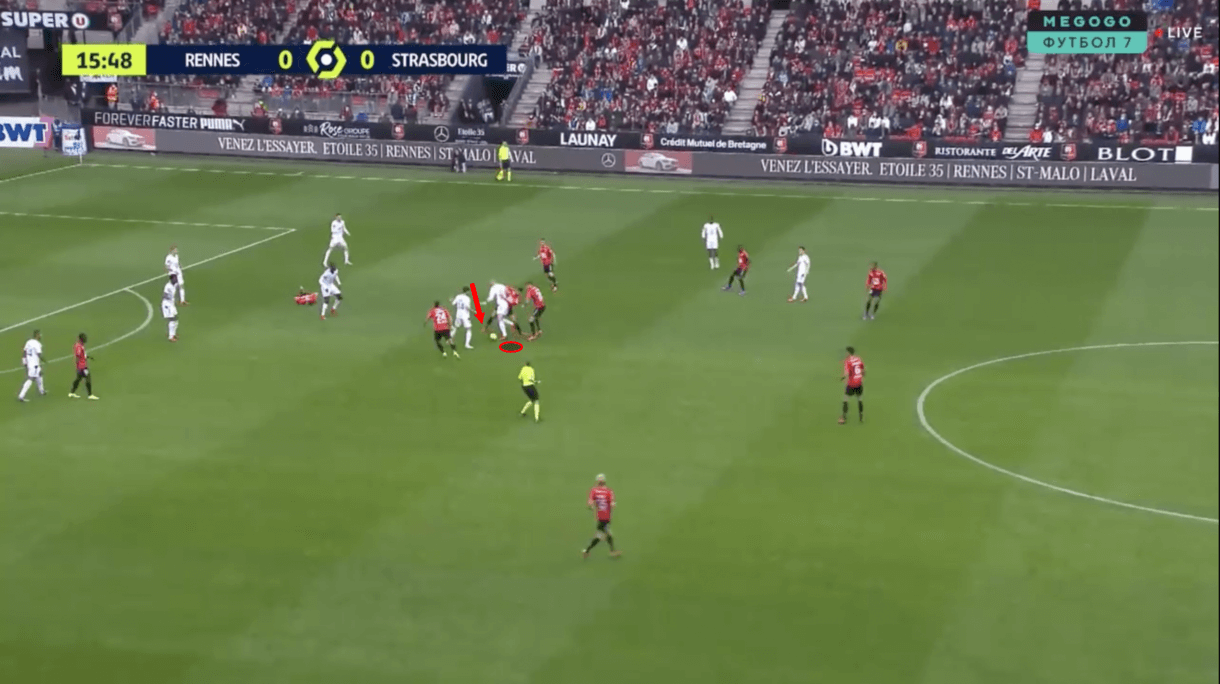
As play moves on into figure 4, with the ball-carrier from figure 3 having been unable to progress via a pass or carry due to the pressure from different opposition players, he played the ball into the nearest passing option’s feet, in hope that this player could progress for Strasbourg instead. However, Terrier was alert to the pass and pounced on this receiver as soon as he was presented with the opportunity.
Thanks to his good positioning, work rate in tracking back, alertness to the opposition’s intent and technical tackling ability, the 24-year-old successfully regains possession for his side high up the pitch in a dangerous, threatening position here, turning a potential counter-attacking opportunity for the opposition into a good counter-attacking opportunity for Rennes. This highlights some of the benefits of a good counter-press, which Terrier is capable of making an excellent contribution to, and regularly does by frequently exhibiting the skills we just mentioned.
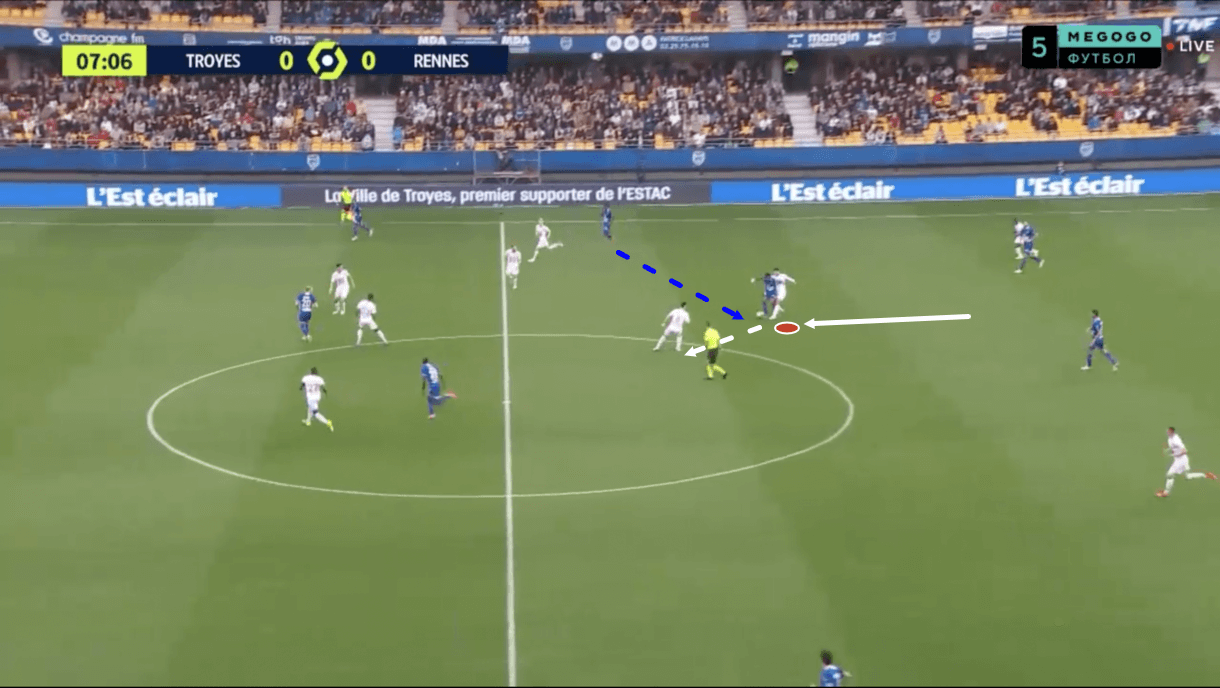
It’s very common to see Terrier pressing backwards to stifle the opposition’s progression and create a good counter-attacking opportunity for his team. We see another example of this in figure 5, where just before this image, the ball was played into the central ball-carrier from the right-wing. This player only just started to control the ball and get his head up to assess his options before he was dispossessed by Terrier, who caught the carrier off-guard to an extent thanks to his effective backwards pressure. This isn’t just effective when counter-pressing, it can be effective any time the opposition are progressing through midfield because Terrier is good at creeping up on players quickly from behind before sticking a foot in and stifling their progression, if not ending their attack entirely by regaining possession for Rennes.
The 24-year-old attacker has a great defensive work rate and typically performs his defensive duties within Génésio’s tactics very well. He’s reliable in terms of pressing volume as well as success rate, as is evident from the statistics we mentioned at the beginning of this analysis section and our video analysis. Terrier is a great asset for counter-pressing too and while he’s great at providing a relentless defensive presence for his side high up the pitch, he’s also diligent in tracking back when required and providing a solid presence in deeper areas too.
When played as a centre-forward / second-striker / attacking midfielder, Terrier tends to provide an excellent presence to stifle opposition progression through central midfield, as figures 3, 4, and 5 show. He could be well utilised in this position when the opposition have a particularly dangerous deep-lying playmaker who could do with some extra attention. As a winger, it’s common to see Terrier playing very deep and narrow within Rennes’ rest defence and performing that role diligently, with discipline. Playing in this position also requires Terrier to play almost as an auxiliary wing-back at times when the opposition progress into a crossing position on the wing, which is a role he also typically performs well. This allows Rennes’ full-backs to stay deeper and tighter to the centre-backs, allowing no space to open up in the backline. All of this highlights Terrier’s versatility and why it is such an asset for his side in defensive phases.
Terrier’s Technique: simple but effective attacking
In terms of technique, ability on the ball and what he offers in possession phases, I’d describe Terrier as a simple but effective attacker. He doesn’t pull off many eye-catching manoeuvres and doesn’t tend to go on mazy runs carrying the ball past multiple defenders — he’s made a relatively low 2.43 dribbles per 90 this term — but he knows his strengths and weaknesses, and can beat players 1v1; the attacker has a good dribble success rate (61.54%) this term, but he ranks in just the 34th percentile for dribble success percentage in the last calendar year when compared to other forwards from Europe’s top-five leagues, which isn’t impressive at all.
Ultimately, he’s not a big dribbler but Terrier’s pace and intelligent movement have helped him to beat defenders successfully this season, while he’s not been attempting to do too much outside of his wheelhouse, which is intelligent. He’ll generally just look to beat players when he has a defender isolated and in a favourable scenario for him.
Terrier ranks in just the 32nd percentile for pass targets, indicating that he isn’t the target of a pass a lot for a forward from Europe’s top-five leagues, but the attacker ranks in the 70th percentile for passes received and the 84th percentile for percentage of passes received, which all highlights that the forward is very good at collecting the passes that are directed towards him. So while Rennes don’t send the ball into him every attack, he’s involved a lot. As we’ll go on to discuss in greater detail later in this tactical analysis, Terrier is great at finding pockets of space to operate in during possession phases. He tends to drop deep when playing centrally during the ball progression and chance creation phases, operating between the lines and acting as a progressive passing option. He loves to engage in link-up play and facilitate connections between teammates; in this way, he often operates as the third man and his skillset suits this role well.
Terrier doesn’t tend to take too much out of the ball, he’s good at finding space via his movement, collecting passes towards him, and then playing a simple pass into another teammate’s feet. In this way, he’s a very good asset for a side that likes to play with patience. The 24-year-old impressively ranks in the 94th percentile for pass completion percentage, which further emphasizes this point.
The forward is a creative threat to some extent but he’s not the biggest direct creative threat you’re ever going to see. He’s somewhat conservative with his defence-splitting pass attempts, which helps his pass completion percentage but maybe can hinder his creative passing numbers to an extent. This isn’t so much a criticism as it is a stylistic point, while this also isn’t to say that Terrier never creates anything — he creates plenty of chances, hence why he ranks in the 72nd percentile for assists, 70th percentile for xA, and 77th percentile for key passes. The attacker could arguably take more risks at times, however, especially when playing in such an advanced position, to create even more for his attacking partners.
Rather than defence-splitting passes, which he does play some of but not a tonne, Terrier’s greatest creative threat may come via his crossing. He loves to be isolated versus a full-back 1v1 out wide before using a subtle movement to beat them or, alternatively, blasting by them with his pace. Terrier’s impressive 53.33% cross accuracy this season highlights his skill in this area; he loves to drive towards the byline before pulling a low driven cross back into the box, while he also glides balls across the face of goal at times. Don’t expect to see him float high balls in that often, however. Terrier is good at getting his head up before crossing, which helps to increase his cross accuracy and threat.
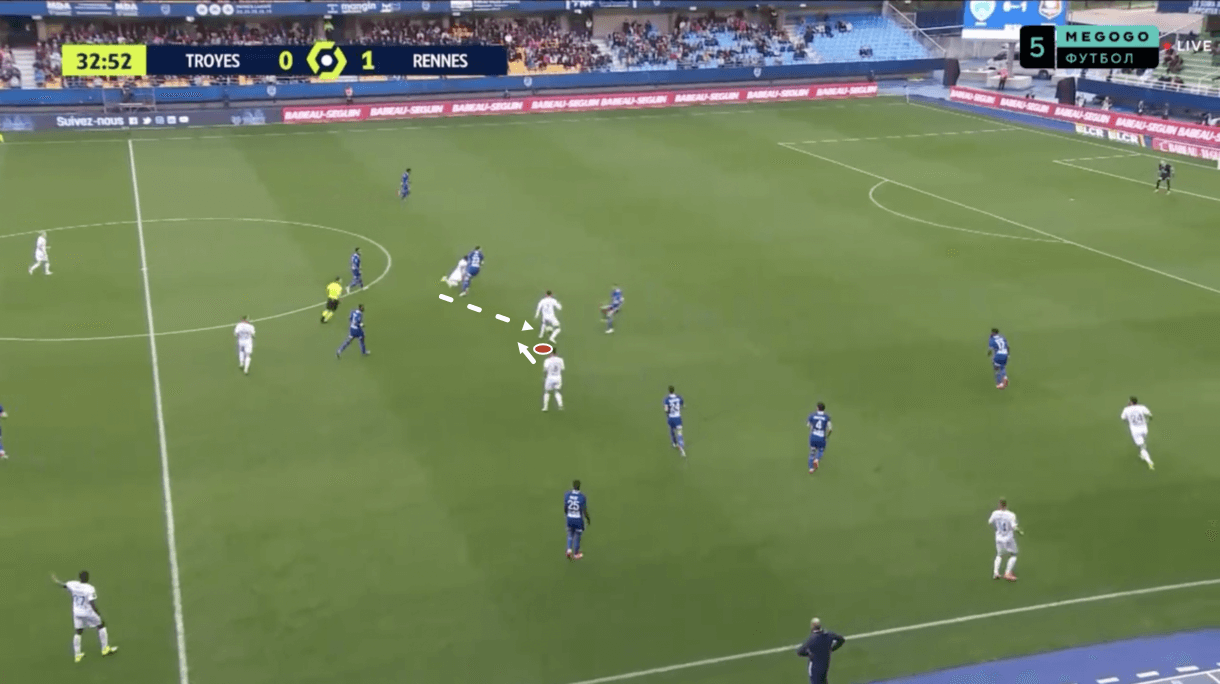
In terms of ability to beat a defender 1v1, Terrier’s pace and intelligent movement are key, as is his constant scanning, which is an evident part of his game when watching the 24-year-old play. Figures 6-7 highlight the attacker’s pace and intelligent movement when looking to beat a man. Firstly, in figure 6, Terrier is receiving the ball in a small bit of space centrally, though he’s coming under increased pressure from the opposition centre-back, who’s been pulled very high up the pitch thanks to Terrier’s movement into a deeper space. While receiving the ball, Terrier takes a big step forward with his left foot and bends slightly, indicating his likely intention to control the pass and move into the direction he’s currently facing.
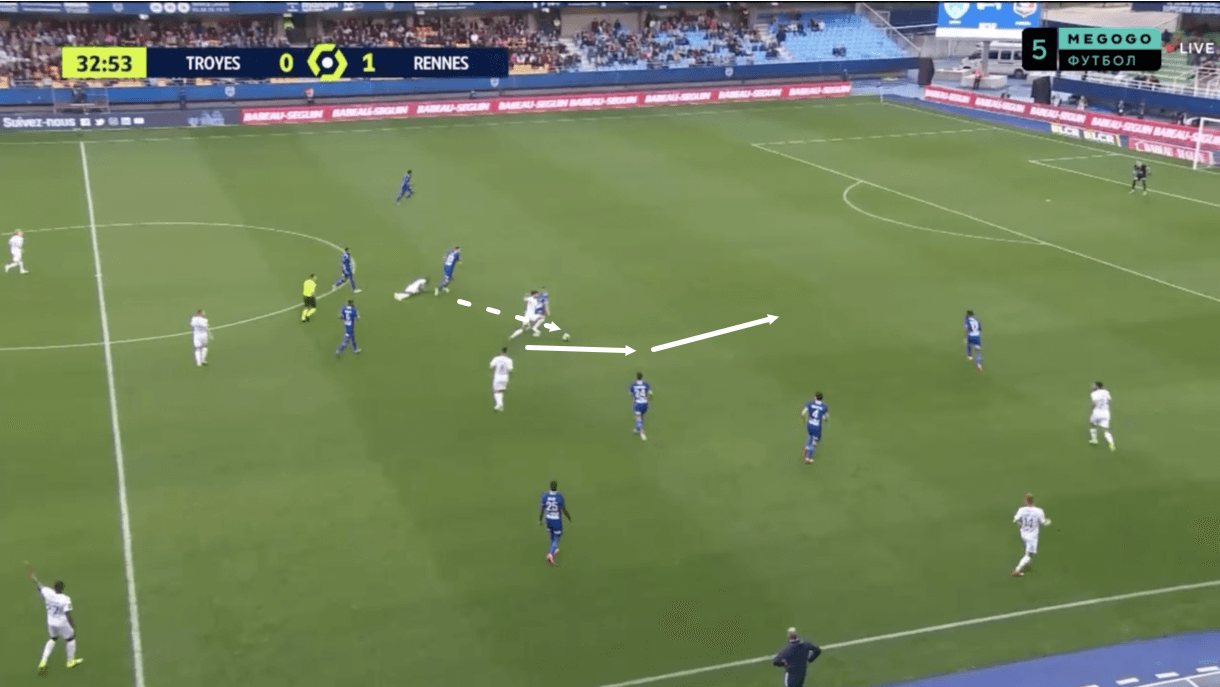
The Rennes man draws the defender in further by taking his time to control the pass into him, giving the defender a window of opportunity to nick the ball away from his feet. However, Terrier shows that he was in control of this situation the whole time in figure 7, as instead of continuing to move forward as previously suggested by his movement, the attacker allows the ball to simply continue rolling across his body, quickly rotates his hips to get facing towards goal, and manages to exit in a completely different (and even more threatening) direction than the one he was previously facing. From here, Terrier could burst into life, accelerating and leaving the defender with whom he contested this duel in his tracks.
His initial step forward and body shape exhibited in figure 6 drew the defender in and manipulated him into committing to blocking the attacker’s progression in the direction he’d been facing. However, this was Terrier’s hope the whole time, as figure 7 shows. This highlights how intelligent body positioning and pace can be very useful tools for Terrier, and all that the attacker needs to beat defenders 1v1 and set up very dangerous attacking scenarios. Again, as mentioned previously, Terrier doesn’t tend to take too much out of the ball and doesn’t tend to try things he’s not capable of, which does drive his dribble volume down but helps make him a reliable asset in attack.
Attacking positioning, movement and shots
In the previous section of analysis, we touched on the fact that Terrier likes to drop deep and exploit space between the lines when playing centrally, rather than mainly offering an option behind the opposition’s backline. He is versatile in his attacking skill-set and does offer an option via runs in behind as well, which we’ll see in this section of analysis, but primarily, you’ll find Terrier in between the lines where he likes to receive passes to feet and engage in link-up play with teammates, often operating as the third man thanks to his reliable passing and good ability to find pockets of space.
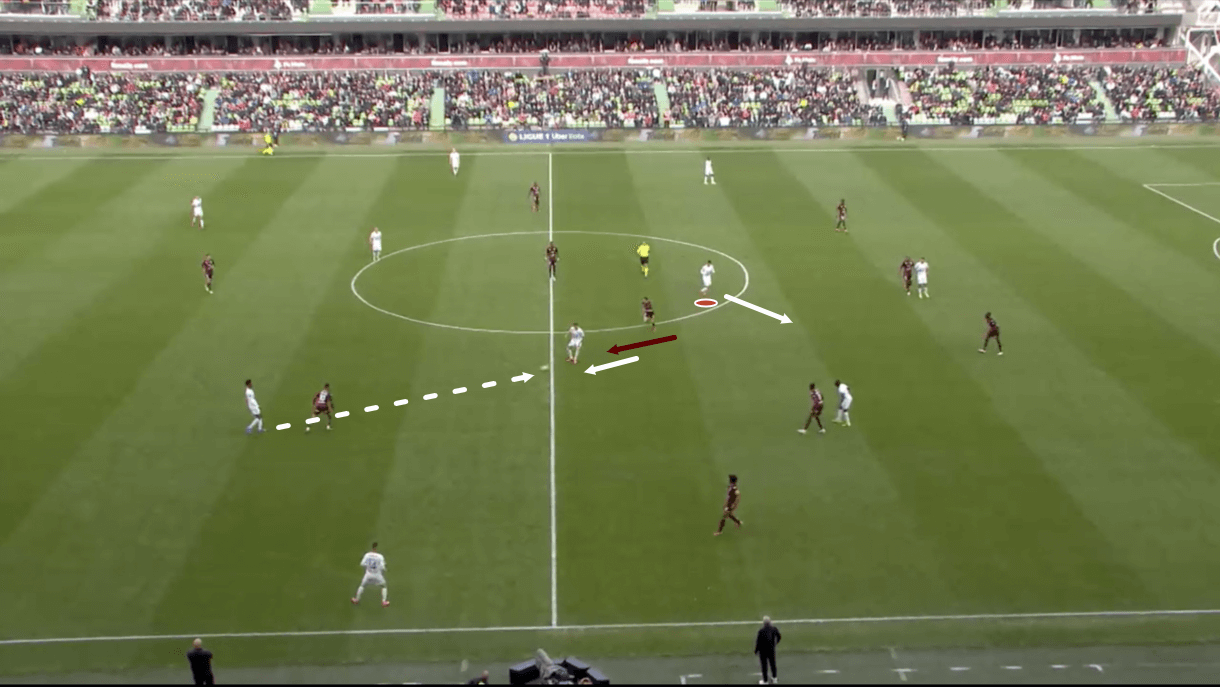
Figures 8-10 show Terrier operating as an attacking midfielder and exploiting space between the lines. This passage of play highlights how Terrier’s movement between the lines and link-up play regularly help his side to progress from the middle third into high-value goalscoring positions. Firstly, in figure 8, we see Rennes progressing from the right centre-back to the right central midfielder. This pass into the right central midfielder draws the opposition’s left central midfielder upfield, creating space behind him for Terrier to target with his movement, which the intelligent attacker does. The 24-year-old’s scanning helps him to spot opportunities to exploit space like this more easily than if he weren’t scanning so regularly. Terrier is diligent with this part of his game, which enhances his movement and decision-making quality.
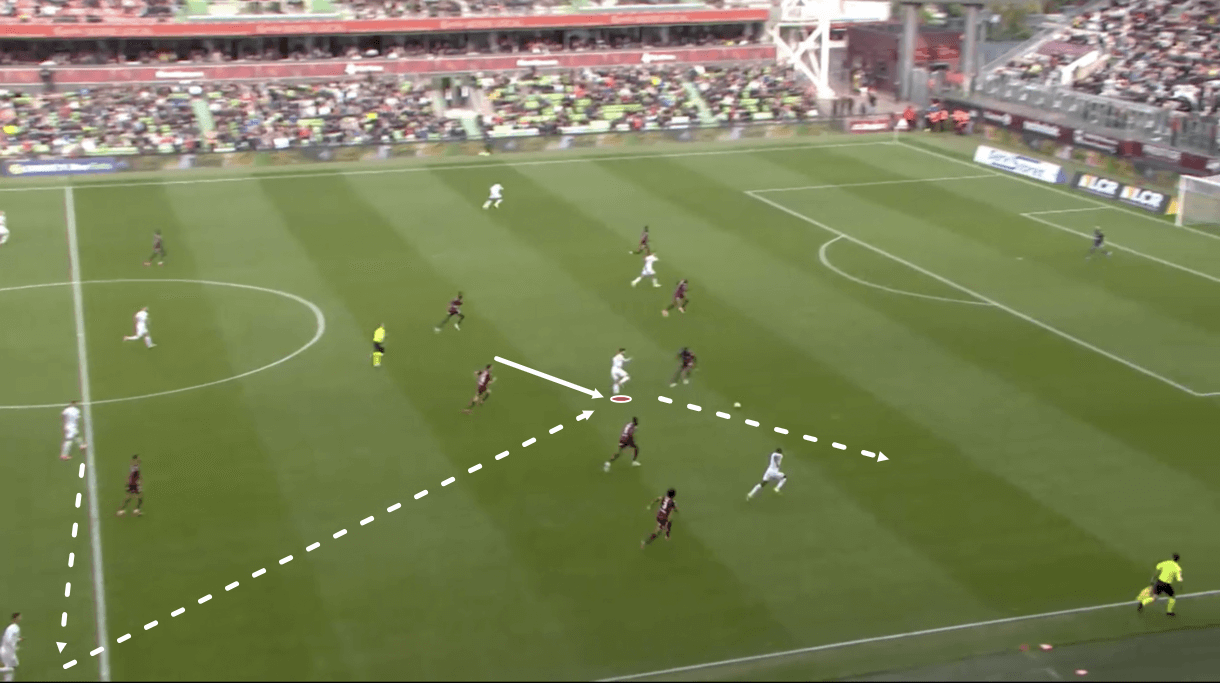
After receiving and drawing some attention to create space elsewhere, Rennes’ right central midfielder quickly plays the ball off to Rennes’ right-back, who had a clear passing lane into Terrier, who enjoyed plenty of space between the opposition’s backline and midfield line thanks to his movement. Terrier carried the ball a few steps forward, into the position we see him occupying in figure 9, and drew an opposition centre-back out towards him in the process, creating extra space for the right-winger to target via his run, as seen in the image above.
After carrying the ball forward for a couple of steps and attracting this pressure from the centre-back, Terrier released a through ball into the right-winger’s path. This example shows the excellence through simplicity that permeates Terrier’s game. Here, the attacker just moves intelligently to find space, receives in that space, progresses as far as he can before attracting pressure, gets his head up to decide on his next move, and executes a good through ball into space — some of which he created himself via his carry. It’s probably fair to say he doesn’t do anything too extravagant or ‘fancy’ but it’s simple and effective. It’s the 24-year-old’s consistency with pulling off this type of simple but effective manoeuvre that makes him stand out and really sets him apart. The effective simplicity of Terrier’s game makes him a joy to watch.
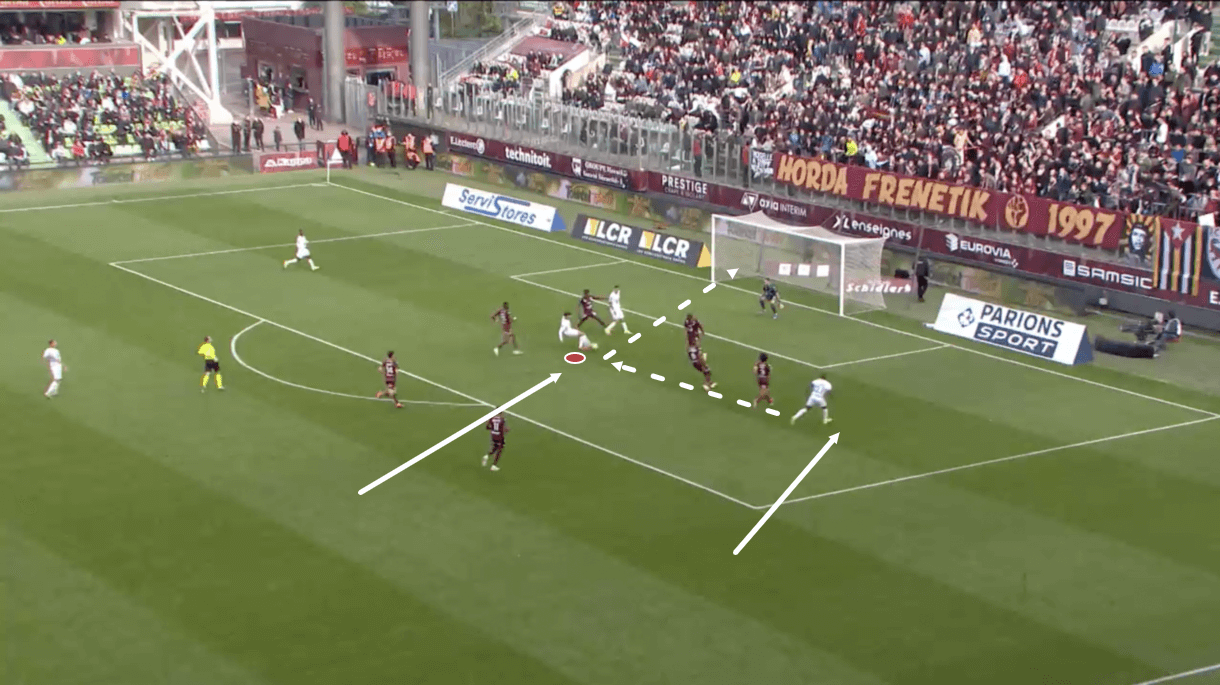
After playing the through ball to the right-winger, the new ball-carrier and Rennes’ centre-forward playing just in front of Terrier in this passage of play burst forward to attack the opposition’s goal, driving the opposition’s defenders backwards to get behind the ball. Meanwhile, Terrier slows down for a couple of seconds, as he has a centre-forward ahead of him to give the winger an immediate option in the box and instead of trying to give another option in the box, he decides to wait to try find space and create a slightly deeper option in the box for the crosser. Terrier arrives late into the box with space in front of him to receive a low cross, run onto the ball and take his shot, as figure 10 shows.
It’s very common to see Terrier make effective late runs into the box like this — it’s a technique he’s very comfortable with. This helps him to catch opposition defenders off-guard and unaware when their primary focus is on getting behind the ball, and get into a goalscoring position unmarked.
After releasing the through ball in figure 9, Terrier just had to bide his time, stay alert and pick the right moment to make his move into the box. The timing of his run was perfect and he ended up essentially ghosting into a very high-value shooting position unmarked from where he could finish into the bottom corner.
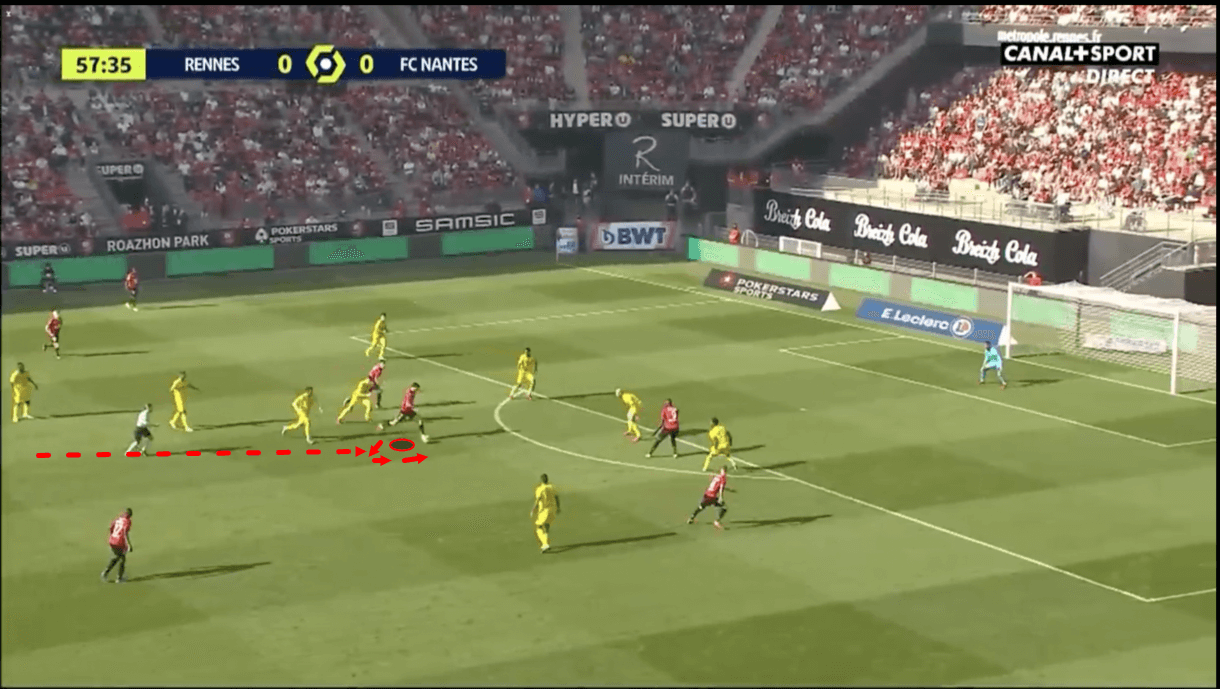
There are two main types of shot/shot location to bear in mind when it comes to Terrier’s game. The first is the type we saw in figure 10, where Terrier occupied a very threatening position from where he could get a shot off unmarked. The other can be seen here in figure 11 — a long shot from about this range we see here, which typically comes from central positions. Terrier generally has very good shot selection; we don’t see him shoot from awkward angles often, even from advanced positions inside the box. Typically, we see him occupying shooting positions like the one we saw in figure 10 inside the box or we see him occupying positions like the one we see in figure 11 when taking on long shots.
Of course, long shots are less likely to result in goals than shots from high-value positions like the one we saw in figure 10. However, Terrier is very good from range and with the attacker being familiar with his specific skill-set and abilities, he makes the informed decision to take on long shots from this type of position seen in figure 11 and enjoys plenty of long-shot success because of it.
This season, Terrier has taken eight shots from outside the box and 21 shots from inside the box (with six of the latter coming from inside the six-yard box), while two of his goals have come from outside the box and three have come from inside the box. So, his long-shot success rate hasn’t been too shabby. Additionally, while he’s taken plenty of long shots, Terrier has got a very impressive 64% shot accuracy rate for the 2021/22 season, while he ranks in the 89th percentile for shot accuracy percentage over the last calendar year.
Terrier’s shot accuracy rate can also be viewed in a somewhat negative light, as one element of his shooting that could improve is the area of goal he’s targeting inside the box, from positions like the one we saw him occupying in figure 10. He could do a better job of trying to find a corner of the net, rather than ‘just’ hitting the target. He’s excellent at doing the latter and this is extremely important. However, Terrier often sees shots from high-value positions saved by ‘keepers with good reactions and/or good positioning. Of course, this is going to happen, but it’s happened on several occasions for Terrier this season and if he’d struck the ball ever so slightly further away from the centre of the net, with the level of power he puts on the ball, it’d likely have been impossible to save, or at least more difficult.
From range, where Terrier typically has more time to line up his strike than when occupying the aforementioned high-value positions close to goal, he’s very good at keeping the ball low while hitting it hard managing to find a corner of the net. This is why his long shot technique is so effective. Additionally, the attacker is good at setting up long shot opportunities in the same way that he’s good at receiving passes in ball progression — he drops deep to find valuable pockets of space, typically receives well on the half-turn but tends to do a good job of scanning beforehand to ensure this is a possibility and generates plenty of power on his strike without the need for a long run-up.
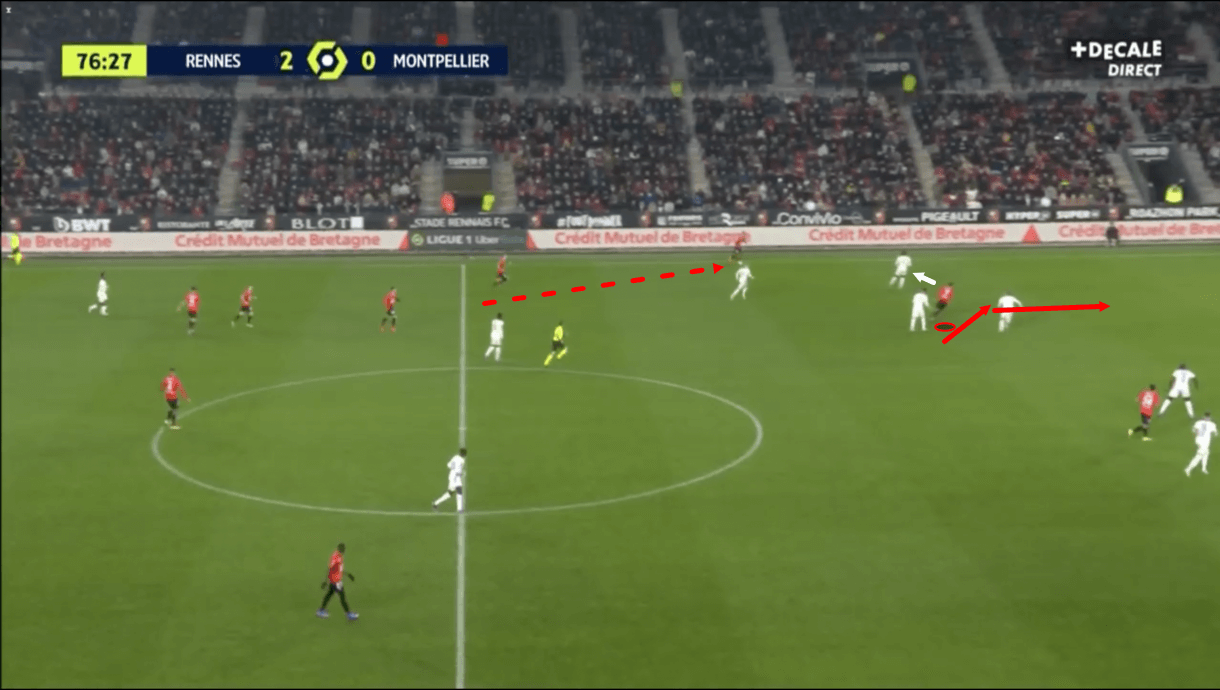
Lastly, in figure 12, we see an example of an occasion when Terrier made a run in behind the opposition’s backline — looking to receive a through pass into space as opposed to a pass to feet, as we’ve seen in previous examples. This is less common than receiving passes to feet but does still occur sometimes, so is worth noting. While this is a less common element of his game, it’s still an effective one. Terrier has excellent spatial awareness and typically demonstrates good off-the-ball movement, in general. Here, the attacker reacts to space opening up behind the opposition’s backline on the left, after the opposition’s right-back has been drawn out wide by a pass to Rennes’ left-winger. Terrier intelligently targets this space as it opens up to give the pass receiver an option in behind.
If Terrier does make runs in behind, it’s common to see them made in the inside channels, particularly the inside left channel, as was the case here. From this position, the 24-year-old will aim to either drive towards the byline before driving a low cutback cross into the box or he’ll look to isolate the right centre-back 1v1, knock the ball past them and create a shooting opportunity on his stronger right foot. One weakness in Terrier’s game is the fact that he’s very right-footed. He rarely uses his left and if he does use it, particularly for shots, the results aren’t usually great.
This passage of play provides another example of how Terrier is very good at reacting to movement from opposition defenders and exploiting space that is created as a result of it.
Conclusion
To conclude this tactical analysis and scout report, I feel Terrier’s greatest traits are his defensive qualities, pace, intelligent movement, and ability to perform the basics of the game to a high standard. The attacker can improve on his finishing technique from close range and also his bravery as a chance creator. If Terrier developed the ability to split defences with his passing more regularly, that would add another element to his game that could take him up to another level.
I think Terrier is at his best when played centrally, and I think the second-striker role suits him very well. However, his versatility is one of his greatest strengths and as mentioned earlier, he’s more than comfortable in several positions and roles.





Comments